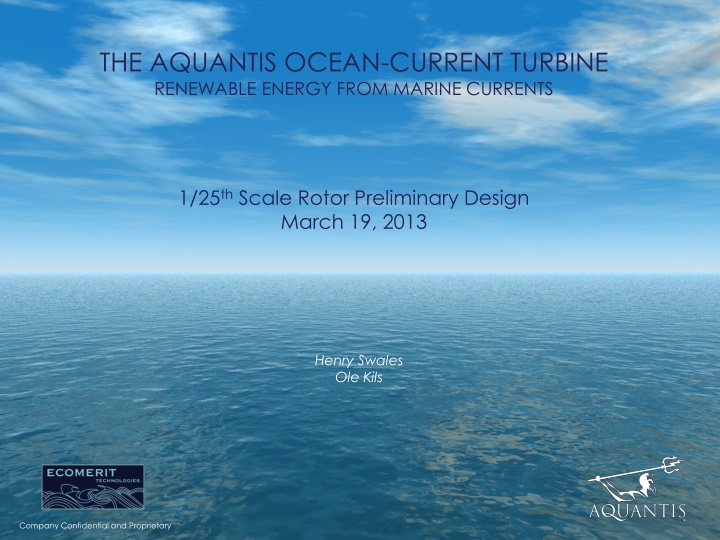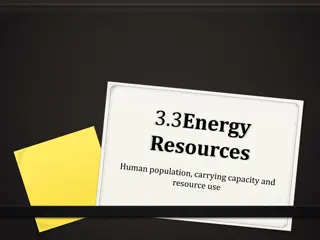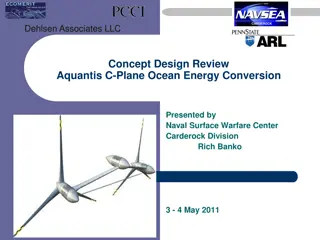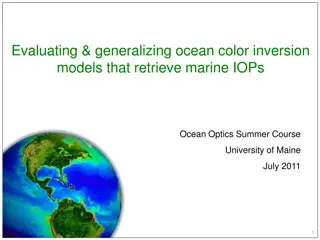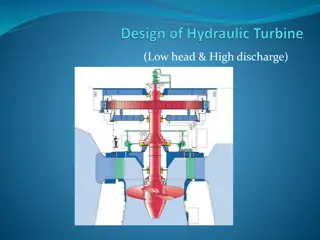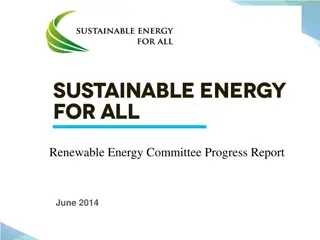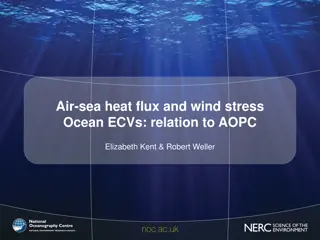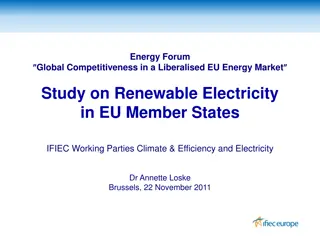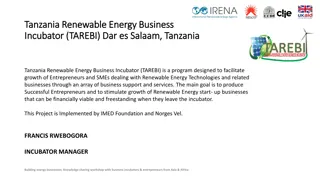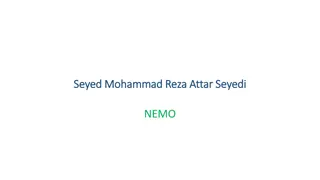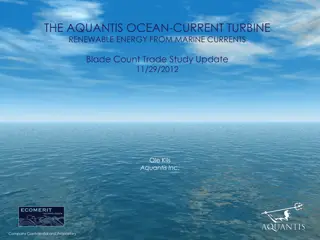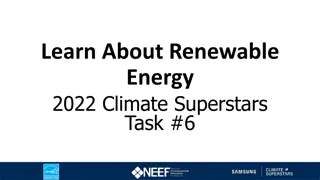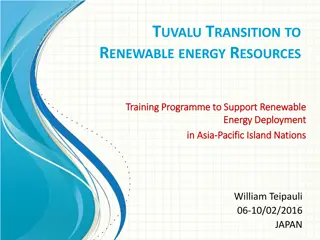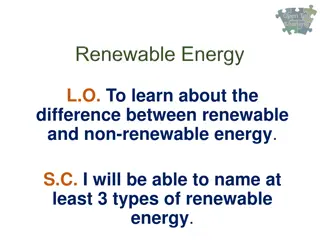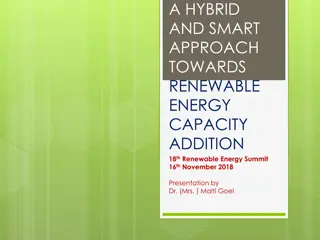Aquantis Ocean-Current Turbine Renewable Energy Design
This document discusses the preliminary design and optimization process for a scaled rotor of the Aquantis ocean-current turbine, focusing on hydrofoil design, airfoil performance, and model scaling. Key aspects include maintaining dynamic stability, minimizing laminar separation bubbles, and achieving accurate thrust scaling. The content delves into the use of thin airfoils, pressure distributions, clean and tripped airfoil performance, and hydrofoil comparisons. The model design process involves optimizing chord, twist, and pitch distributions for efficient energy generation from marine currents.
Download Presentation

Please find below an Image/Link to download the presentation.
The content on the website is provided AS IS for your information and personal use only. It may not be sold, licensed, or shared on other websites without obtaining consent from the author.If you encounter any issues during the download, it is possible that the publisher has removed the file from their server.
You are allowed to download the files provided on this website for personal or commercial use, subject to the condition that they are used lawfully. All files are the property of their respective owners.
The content on the website is provided AS IS for your information and personal use only. It may not be sold, licensed, or shared on other websites without obtaining consent from the author.
E N D
Presentation Transcript
THE AQUANTIS OCEAN-CURRENT TURBINE RENEWABLE ENERGY FROM MARINE CURRENTS 1/25th Scale Rotor Preliminary Design March 19, 2013 Henry Swales Ole Kils Company Confidential and Proprietary Company Confidential and Proprietary
Conceptual Approach Re-Design rotor for model scale using hydrofoils designed and tested for tow tank Re# of 168k. Maintain Froude scaling of thrust, diameter and rotor speed for dynamic stability tests. Minimize performance instabilities due to laminar separation bubbles. Company Confidential and Proprietary
SD2030 Pressure Distributions Utilize very thin airfoil with long transition ramp developed for low Re# sail planes and wind turbines. Minimizes laminar separation bubble thickness. Airfoil SD2030 Thickness (%) 8.56 Camber (%) 2.23 Cm,c/4 0.075 Company Confidential and Proprietary
Clean Airfoil Performance Despite low Re# design, clean airfoil test data still displays some evidence of a laminar separation bubble at Re# = 100k to 200k. Company Confidential and Proprietary
Tripped Airfoil Performance Test data with a leading edge trip shows minimal laminar separation bubble impact on performance at Re#=100,000. Tripping the boundary layer is also more representative of the fully turbulent flow regime expected at full scale. Full Scale Re# @ 0.7R = 10,000,000 Company Confidential and Proprietary
Hydrofoil Comparison 2 0.1 70 0.09 1.5 60 0.08 50 1 0.07 Cl SD2030 40 0.06 0.5 L/D Cl S816 Cd 0.05 Cl SD2030 30 0 Cd SD2030 0.04 S816 -6 -4 -2 0 2 4 6 8 101214161820 20 Cd S816 0.03 -0.5 10 0.02 -1 0.01 0 0 2 4 6 8 10 12 14 -1.5 0 AoA (deg) AoA (deg) Model: SD2030 @ Re# = 100k Design Point: 4deg Stall Marin: 8deg Full Scale: S816 @ Re# = 10M Design Point: 5deg Stall Margin: 10deg Company Confidential and Proprietary
Model Design Process PropID used to optimize chord and twist of all stations for axial induction = 0.342 at 4deg AoA with Rho = 1000 (kg/m^3). Axial induction increased 2.59% to attain accurate thrust scaling in fresh water. Re# = 100k test data Diameter and RPM Froude scaled. Full Scale reference rotor: 45.5m 30% Thick Estimate Hydro Loop2 Twist + Pitch Distribution Chord Distribution 25 1.2 1.0 20 Twist + Pitch (deg) 0.8 Chord (ft) 15 0.6 10 0.4 5 0.2 0.0 0 0.0 0.5 1.0 1.5 2.0 2.5 3.0 0.0 0.5 1.0 1.5 2.0 2.5 3.0 Radial Position, r (ft) Radial Position, r (ft) Company Confidential and Proprietary
Model Rotor Hydrodynamics Axial Induction: 0.342 Re#: 168k Design Cl: 0.65 Axial Induction Factor Distribution 0.40 0.35 0.30 Axial Inflow Coefficient, a 0.25 0.20 0.15 0.10 0.05 0.00 0 0.1 0.2 0.3 Normalized Radial Position, r/R 0.4 0.5 0.6 0.7 0.8 0.9 1 Reynolds Number Distribution - SeaWater Lift Coefficient Distribution 200,000 0.9 180,000 0.8 Reynolds Number, Re 160,000 0.7 Lift Coefficient, cl 140,000 0.6 120,000 0.5 100,000 0.4 80,000 0.3 60,000 0.2 40,000 0.1 20,000 0.0 0 0 0.1 0.2 0.3 Normalized Radial Position, r/R 0.4 0.5 0.6 0.7 0.8 0.9 1 0 0.1 0.2 0.3 0.4 0.5 0.6 0.7 0.8 0.9 Normalized Radial Position, r/R 1 Company Confidential and Proprietary
Performance Comparison Similar performance at design point: Model Cp: 0.428 Full scale Cp: 0.425 Model Lift-to-Drag Ratio Distribution Full-Scale Lift-to-Drag Ratio Distribution 80 80 Lift-to-Drag Ratio, cl/cd Lift-to-Drag Ratio, cl/cd 60 60 40 40 20 20 0 0 0 0.1 0.2 0.3 0.4 0.5 0.6 0.7 0.8 0.9 1 0 0.1 0.2 0.3 0.4 0.5 0.6 0.7 0.8 0.9 1 Normalized Radial Position, r/R Normalized Radial Position, r/R Company Confidential and Proprietary
Reynolds Number Calibration Drag Coeff. Lift Coeff. Airfoil A Airfoil A 0.16 Airfoil B 1.4 Airfoil B 1.2 Blended airfoil 0.14 Blended airfoil 1 0.12 0.8 0.1 0.6 0.4 0.08 0.2 0.06 0 -10 -5 0 5 10 15 0.04 -0.2 0.02 -0.4 -0.6 0 -10 -5 0 5 10 15 Angle of Attack, deg Airfoil A = 100k Re# Airfoil B = 200k Re# Blended Airfoil = 168k Re# Company Confidential and Proprietary
Design Point (TSR = 8) Comparisons 0.018 0.09 0.30 Froude Scaled Flap Root Moment 0.016 0.08 Froude Scaled Torque (kN*m) 0.25 Froude Scaled Thrust (kN) 0.014 0.07 0.012 0.06 0.20 0.010 (kN*m) 0.05 0.15 0.008 0.04 0.006 0.03 0.10 0.004 0.02 0.002 0.05 0.01 0.000 0.00 0.00 0 20 40 60 0 20 40 60 0 20 40 60 Froude Scaled Rotor Speed (RPM) Froude Scaled Rotor Speed (RPM) Froude Scaled Rotor Speed (RPM) Froude Scaled 45.5m Data Froude Scaled 45.5m Data Froude Scaled 45.5m Data Rotor thrust scales very well at the design TSR 0.6% difference well within test accuracy. Rotor Torque: 2.7% difference Root Bending Moment: 3.1% difference Company Confidential and Proprietary
Off-Design Comparisons (1.9m/s) 0.014 0.080 0.250 Froude Scaled Flap Root Moment Froude Scaled Torque (kN*m) 0.070 0.012 Froude Scaled Thrust (kN) 0.200 0.060 0.010 0.050 0.150 0.008 (kN*m) 0.040 0.006 0.100 0.030 0.004 0.020 0.050 0.002 0.010 0.000 0.000 0.000 0 2 4 6 8 10 12 14 16 0 2 4 6 8 10 12 14 16 0 2 4 6 8 10 12 14 16 TSR TSR TSR Froude Scaled 45.5m Data Froude Scaled 45.5m Data Froude Scaled 45.5m Data Model Data Model Data Model Data TSR=6 is minimum computed with test data. Lower values use Viterna flat-plate approximation. Thrust diverges from scaled values at TSR above design point. Only test cases that experience TSR above 8.0 are hydraulic failures. Differences in off-design performance result from hydrofoil, Re#, and AoA differences. See next slide and previous hydrofoil polar data plots. May be able to adjust blade pitch or TSR to improve thrust accuracy for off-design cases based on results of captured test. Company Confidential and Proprietary
Blade Element Data 0.9 20 Induced Flow Velocity Angle Axial Induction 0.8 0.7 15 0.6 Full Scale TSR=8 Full Scale TSR=8 0.5 Deg 10 a 0.4 Model TSR=8 Model TSR=8 0.3 Full Scale TSR=16 Full Scale TSR=16 5 0.2 Model TSR=16 Model TSR=16 0.1 0 0 0 1 2 3 4 5 6 7 8 9 10 0 1 2 3 4 5 6 7 8 9 10 Blade Element Number Blade Element Number 1.8 0.4 Thrust Coefficient Torque Coefficient 1.6 0.35 1.4 0.3 1.2 0.25 Full Scale TSR=8 Full Scale TSR=8 1 Ct 0.2 0.8 Model TSR=8 Model TSR=8 Cq 0.15 0.6 Full Scale TSR=16 Full Scale TSR=16 0.1 0.4 Model TSR=16 Model TSR=16 0.2 0.05 0 0 0 1 2 3 4 5 6 7 8 9 10 0 1 2 3 4 5 6 7 8 9 10 Blade Element Number -0.05 Blade Element Number Difference in Cl drives discrepancy in high-TSR axial induction and rotor thrust. Company Confidential and Proprietary
Additional Analysis Cavitation Check Min. Cavitation Number: 4.7 TSR=14.5, Flow Speed: 0.5m/s, Hub Depth: 2m Cpmin estimated to be ~ -4.0 at Clmax verify with Xfoil analysis Off-Design TSR Viterna flat-plate post-stall Start-up Torque w/o pitch control 1.2 1.0 0.8 0.6 0.4 0.2 0.0 -10 0 10 20 30 40 50 60 70 80 90 CL CD AoA (deg) Viterna Flat-Plate Post-Stall Estimation Company Confidential and Proprietary
Scaled Blade Design Model Blade Design Requirements: Pitch adjustability of +-0.5deg. Trailing edge thickness of ~0.1mm. Ability to operate in submerged environment. Mass and CG to be evaluated for inertial match. Company Confidential and Proprietary
Scaled Blade Design Extreme Loads Design Point TSR Rotor Speed Flow Speed Pitch Diameter 8.000 41.975 RPM 0.500 m/s -1.504 deg 1.820 m Absolute Thickness (m) Relm (m) Twist (deg) Chord (m) Relative Thickness (t/c %) Thr/Len (N/m) Trq/Len (N) # r/R 0 0 100% 0.092 0.092 0.062 0.050 0.150 0.250 0.350 0.450 0.550 0.650 0.750 0.850 0.950 0.046 0.137 0.228 0.319 0.41 0.501 0.592 0.683 0.774 0.865 23.553 23.553 15.078 10.558 7.833 6.032 4.758 3.812 3.083 2.503 0.092 0.155 0.218 0.167 0.134 0.111 0.094 0.08 0.066 0.042 100.00% 40.00% 8.56% 8.56% 8.56% 8.56% 8.56% 8.56% 8.56% 8.56% 9.1 37.5 79.3 111.0 142.7 174.1 204.4 230.6 242.7 192.1 0.365 2.784 5.23 7.286 9.173 10.904 12.438 13.608 13.763 10.44 1 2 3 4 5 6 7 8 9 0.0186608 0.0142952 0.0114704 0.0095016 0.0080464 0.006848 0.0056496 0.0035952 10 Company Confidential and Proprietary
Scaled Blade Design Company Confidential and Proprietary
Scaled Blade Design Proposed Structure Rapid Prototyping with Watershed XC11122 ABS-Like Properties 2650 MPa Tensile Modulus 47.1 MPa min Tensile Strength (ASTM D638) Max root moment of 76 N-m Very thin airfoil for hydrodynamic scaling 8.56% Initial calculations show ABS-type material is feasible Working with rapid prototype company to assess manufacturing feasibility and costs. Company Confidential and Proprietary
Scaled Blade Design Proposed Structure Basic structural analysis performed for strain analysis Assumes no twist in calculation Assumes principal axes of airfoil are aligned with chord line. Material safety factor of 1.35 Tip deflection calculation pending Detailed 3D model pending Company Confidential and Proprietary
Scaled Blade Design Pitch Adjustment Considerations for adjustable pitch Easy manual adjustment of pitch +-2deg with intervals of +-.5deg desired Sleeve connection of root envisioned with 9 tapered axial holes for insertion of alignment pins. Next Steps Define manufacturing plan Detailed 3D sectional stress analysis Root connection and pitch adjustment design Company Confidential and Proprietary
Next Steps 1. Resolve high-TSR thrust discrepancy 2. 3D Effects 3. Rotational Inertia 4. Root Attachment Pitch adjustment 5. Loft Company Confidential and Proprietary
